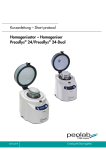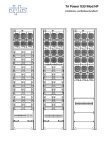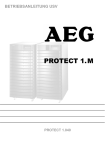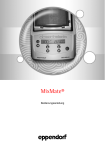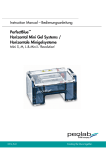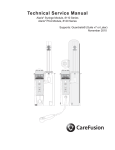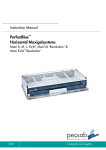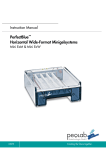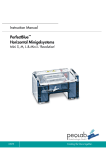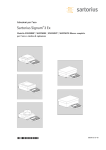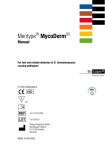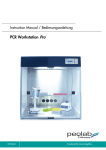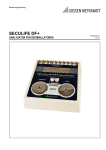Download MINILYS Arbeitsplatzhomogenisator
Transcript
Kurzanleitung – Short protocol
Arbeitsplatz-Homogenisator – benchtop homogeniser
MINILYS
v0314D+E
Creating the future together.
INHALT / CONTENT
GARANTIE
1
LIEFERUMFANG
1
SICHERHEITSHINWEISE
1
SYSTEMÜBERBLICK
2
Technische Merkmale
Technische Merkmale
Hinweise zur sicheren Verwendung geeigneter Aufschlussgefäße
INBETRIEBNAHME
Entfernen der Transportsicherung
Installation und Probenfixierung
Programmierung/Programm-Start und -Abbruch
Programmierung/Programm-Start und -Abbruch
Display und Bedienelemente
Reinigung und Dekontamination
Reinigung und Dekontamination
2
3
3
4
4
4
4
5
5
5
6
TROUBLESHOOTING
6
APPLIKATIVE HINWEISE
7
Allgemeine Anwendungstipps
Welches Aufschluss-Kit für welches Ausgangsmaterial?
Weiterführende Anwendungstipps
7
8
8
TECHNISCHER SERVICE UND BESTELLINFORMATIONEN
9
Arbeitsplatz-Homogenisator MINILYS und Ersatzteile
Precellys®-Aufschlusskits für MINILYS
Precellys RNA-Isolierungskits (optional)
Precellys DNA-Isolierungskits (optional)
ENGLISH VERSION OF THIS INSTRUCTION MANUAL
PEQLAB_v0314_D+E
9
9
10
10
11 ff.
Kurzanleitung Arbeitsplatz-Homogenisator MINILYS
GARANTIE
PEQLAB garantiert, dass das ausgelieferte System genauestens geprüft wurde und den geltenden Anforderungen entspricht. Bitte überprüfen Sie die Lieferung dennoch umgehend nach Erhalt auf Vollständigkeit und eventuelle Transportschäden. Sollte die Lieferung beschädigt oder fehlerhaft sein, wenden
Sie sich bitte umgehend an den Technischen Service von PEQLAB oder Ihren PEQLABAußendienstmitarbeiter (siehe 'TECHNISCHER SERVICE & BESTELLINFORMATIONEN'). Die Aufbewahrung des Verpackungsmaterials bis zur vollständigen Prüfung der Lieferung schont die Umwelt und beschleunigt eine evtl. Rückholung. Rücksendungen, Austauschlieferungen und Gutschriften müssen zuvor
von PEQLAB freigegeben werden.
Auf den Homogenisator MINILYS gewährt PEQLAB 24 Monate Garantie, sofern das System ausschließlich der Bedienungsanleitung entsprechend verwendet wurde und keine anderslautende Vereinbarung
besteht. Von der Garantie ausgeschlossen sind die elektrischen Sicherungen und die Tube-Adapter.
Ansprüche auf Ersatz oder Reparatur, die aus einer fehlerhaften Verwendung entstanden sind, werden
nicht erfüllt. Die PEQLAB GmbH verpflichtet sich zur Reparatur, Ersatz des Gerätes oder Rückerstattung
des Kaufpreises nach ihren Bedingungen. PEQLAB haftet nicht für Folgeschäden, die aus der Verwendung des Systems entstanden sind. Um Neuentwicklungen zeitnah einführen zu können, behält es sich
PEQLAB bzw. der Hersteller BERTIN TECHNOLOGIES vor, technische Details ohne Vorankündigung zu
ändern.
LIEFERUMFANG
Sofern nicht anders vereinbart bzw. auf dem Lieferschein angegeben, enthält der Lieferumfang des
MINILYS folgende Komponenten:
Ein umfangreiches 'User Manual' in englischer Sprache mit ausführlichen Informationen zu Installation, sicherem Betrieb und Wartung
Diese 'Kurzanleitung' in deutscher und englischer Sprache mit wesentlichen Informationen zu Installation, Betrieb und Anwendung
1 x MINILYS Arbeitsplatz-Homogenisator
1 x Netzkabel
2 x Adapter für 0.5/2 ml Schraubdeckelgefäße
2 x Adapter für 7 ml Schraubdeckelgefäße
1 x Transportsicherungsschraube
SICHERHEITSHINWEISE
Lesen Sie das mitgelieferte vollständige 'User Manual' vor Inbetriebnahme sorgfältig durch.
Trennen Sie das System von der Stromversorgung, sobald es mit Flüssigkeiten in Kontakt gerät.
Das System muss immer vollständig auf den 4 Füßen stehen.
Führen Sie keine Veränderungen an Bauteilen und/oder Software-Komponenten durch.
Betreiben Sie das System niemals nach Entfernen oder bei deutlicher Beschädigung des Gehäuses.
Öffnen Sie den Deckel des Gerätes erst, wenn der Probenhalter zum Stillstand gekommen ist.
Bitte beachten Sie das Kapitel 'Hinweise zur sicheren Verwendung geeigneter Aufschlussgefäße'.
Entfernen Sie vor Inbetriebnahme unbedingt die Transportsicherungsschraube im Geräteboden.
Keine Proben im Gerät bearbeiten, die explosive oder leicht-entzündliche Stoffe enthalten.
PEQLAB_v0314_D+E
1
Kurzanleitung Arbeitsplatz-Homogenisator MINILYS
SYSTEMÜBERBLICK
Der Arbeitsplatz-Homogenisator MINILYS ermöglicht den gleichzeitigen Aufschluss von bis zu 3 Proben
im 0.5/2.0 ml-Maßstab oder von einer Probe im 7 ml-Maßstab.
Das Aufschlussprinzip beruht auf dem Zermahlen des Probenmaterials mittels hochbeschleunigter Keramik-, Stahl- oder Glaskügelchen in 0.5 ml-, 2.0 ml- oder 7.0 ml-Schraubdeckelgefäßen, welche als sogenannte 'Precellys-Kits' zur Verfügung stehen (siehe 'TECHNISCHER SERVICE UND BESTELLINFORMATIONEN').
Dazu werden die befüllten Gefäße im Probenhalter des MINILYS einer intensiven Schüttelbewegung in
Form einer dreidimensionalen 8 ausgesetzt. Aufgrund dieser besonders effektiven Aufschlussbewegung,
durch die Wahl geeigneter Aufschlusskügelchen und das Anpassen von Schüttelgeschwindigkeit und
–dauer, lassen sich beste Homogenisierungsergebnisse für eine Vielzahl auch anspruchsvoller Ausgangsmaterialen und Anwendungen erzielen (siehe 'APPLIKATIVE HINWEISE').
Das genial einfache Verschlusssystem des MINILYS ermöglicht schnelles Beladen des Probenhalters und
sicheres Fixieren der Probengefäße ohne auf Schrauben und Werkzeuge angewiesen zu sein. Ein Deckelsensor überwacht den Verschlusszustand und lässt das Starten der Aufschlussbewegung nicht zu
bzw. bricht diese ab, wenn der Deckel geöffnet ist bzw. wird.
Sicherheitsdeckel
(geschlosssen)
LED-Anzeige und
Bedienelemente
Lüftungsschlitze
Netzschalter
Ein/Aus
Netzanschluss
Sicherheitsdeckel
(geöffnet)
Fixierbügel
Tube-Adapter
Probenhalter
LED-Anzeige und
Bedienelemente
PEQLAB_v0314_D+E
2
Sicherung
Kurzanleitung Arbeitsplatz-Homogenisator MINILYS
Technische Merkmale
Elektrische Eigenschaften
Spannungsbereich
110 - 230 V, 50 - 60 Hz (europäischer und US-Standard)
Leistungsaufnahme
< 250 VA
Spezifikation der elektr. Sicherung
5 x 20 – F 2 A – H 250 V
Einstufung
Klasse A
Physikalische Eigenschaften
Abmessungen (B x H x T)
18 cm x 26 cm x 37 cm
Gewicht
7.8 kg
Geräuschpegel bei maximaler Leistung
< 75 dB
Umgebungsbedingungen
Temperatur und Luftfeuchte
15 - 40 °C / 15 - 85 % HR
Höhe (über NN)
< 2000 m
Aufschlussparameter
Programmspeicherplatz
1 (das zuletzt gelaufene)
Schüttelgeschwindigkeiten
3000 rpm, 4000 rpm, 5000 rpm
Dauer eines Schüttelintervalls
5 - 240 s, in Schritten von 1 s
Refraktärzeit zwischen zwei Läufen
keine
Beschleunigungszeit (0 auf 5000 rpm)
<2s
Abbremszeit (5000 auf 0 rpm)
<4s
Probenkapazität
Probenzahl pro Lauf
1 - 3 Proben im 0.5 ml- oder 2.0 ml-Maßstab oder
1 Probe im 7 ml-Maßstab
Maximales Probenvolumen
(Probe + Puffer)
70 % des maximalen Füllvolumens, z. B. 1.4 ml bei Verwendung
eines 2.0 ml-Gefäßes
Hinweise zur sicheren Verwendung geeigneter Aufschlussgefäße
Je nach verwendeten Aufschlussparametern (Dauer, Geschwindigkeit), Durchmesser und Beschaffenheit
der Aufschlusskügelchen sowie Probenmenge und -Art kommt es zu einer mehr oder weniger großen
thermischen und mechanischen Belastung der Aufschlussgefäße.
Um ein Platzen der Aufschlussgefäße während der Homogenisation zu vermeiden, sollten ausschließlich
die von PEQLAB angebotenen Aufschlussgefäße verwendet werden (siehe TECHNISCHER SERVICE
UND BESTELLINFORMATIONEN).
Bei Verwendung von 7 ml-Gefäßen sollten Aufschlusszeiten von 120 s nicht überschritten werden, ohne
die Proben zwischen solchen Aufschlussintervallen zu kühlen, da es ansonsten zu einer Havarie aufgrund reibungsbedingter Wärmeausdehnung kommen kann.
Um für Wärmeausdehnung ausreichend komprimierbares Volumen zur Verfügung zu stellen, sollten die
Aufschlussgefäße maximal zu 70 % gefüllt werden.
Bei Verwendung von 2 ml-Gefäßen, die mit Keramik- oder Stahlkügelchen des Durchmessers 2.8 mm
befüllt sind, sollte das Probenvolumen mindestens 500 μl betragen oder auf die alternativ erhältlichen
'verstärkten' 2 ml-Gefäße zurückgegriffen werden (siehe hierzu auch 'APPLIKATIVE HINWEISE').
PEQLAB_v0314_D+E
3
Kurzanleitung Arbeitsplatz-Homogenisator MINILYS
INBETRIEBNAHME
Entfernen der Transportsicherung
Zum Schutz vor Transportschäden fixiert eine weiße
Schraube das Geräteinnere. Sie befindet sich auf der Geräteunterseite und muss vor Inbetriebnahme des Geräts entfernt werden.
Transportsicherung auf der Geräteunterseite
Die Schraube kann einfach per Hand aus dem Gerät herausgedreht werden. Das Gerät muss hierfür unbedingt aufrecht stehen (s. Foto). Auf der Seite liegend steht die
Schraube unter Zug durch das Gewicht des Motors und ist
von Hand nicht zu lösen.
Bewahren Sie die Schraube sorgfältig auf, um diese im
Falle eines zukünftigen Transports wieder zur Sicherung
verwenden zu können.
Aus/Einschrauben der Transportsicherung
Installation und Probenfixierung
Stellen Sie Ihren MINILYS Arbeitsplatz-Homogenisator auf
einen ebenen und tragfähigen Untergrund; im Abstand von
mind. 15 cm von benachbarten Geräten oder Wänden, um
eine optimale Luftkühlung zu gewährleisten. Verbinden Sie
das Gerät unter Verwendung des mitgelieferten Netzkabels
mit dem Stromnetz.
0.5/2 ml-Adapter (links), 7 ml-Adapter (rechts)
Öffnen Sie den Sicherheitsdeckel und setzen Sie einen der
mitgelieferten Adapter in den Probenhalter ein, je nach
dem, ob 0.5/2.0 ml- oder 7 ml-Gefäße verwendet werden
sollen.
Beladen Sie den Adapter mit Ihren Probengefäßen. Bei
Verwendung des 0.5/2 ml-Adapters und nur eines Reaktionsgefäßes, stecken Sie dieses bitte in die mittlere Bohrung.
FIXIEREN SIE DIE PROBENGEFÄßE DURCH UMLEGEN
UND EINRASTEN DES FIXIERBÜGELS!
Fixieren der Probengefäße
PEQLAB_v0314_D+E
4
Kurzanleitung Arbeitsplatz-Homogenisator MINILYS
Programmierung/Programm-Start und -Abbruch
Schalten Sie das Gerät über den Netzeingangsschalter
an der Geräterückseite ein.
Wählen Sie die gewünschte Aufschlussdauer (time) mit
Hilfe der +/- Tasten. Einmaliges Drücken verändert sekundengenau, längeres Drücken verändert die Einstellung in größeren Intervallen.
Wählen Sie eine der drei Aufschlussgeschwindigkeiten
mit Hilfe der +/- Tasten. Das Leuchten der linken LED
bedeutet 3000 rpm, der mittleren LED 4000 rpm und
der rechten LED 5000 rpm.
Zum Starten der Homogenisation drücken Sie 'start'. Die
Homogenisation erfolgt nun bei gewünschter Geschwindigkeit und Dauer.
Die Homogenisation kann jederzeit durch Drücken von
'stop' abgebrochen werden.
Das Öffnen des Sicherheitsdeckels führt ebenfalls zum
sofortigen Abbruch der Aufschlussbewegung.
Bedientasten/Display
Im Anschluss an eine erfolgte Homogenisation können die Proben entnommen und neue Proben – bei
Bedarf umgehend, ohne Refraktärzeit – bearbeitet werden.
Nach Aus- und Wiedereinschalten des Systems erscheinen die zuletzt verwendeten Aufschlussparameter
im Display und stehen zur sofortigen Nutzung zur Verfügung.
Display und Bedienelemente
Homogenisierungsdauer [s]
Programmierung
und Anzeige
Aufschluss-ZEIT
Programmierung
und Anzeige
Aufschluss-GESCHWINDIGKEIT
Gewählte Geschwindigkeit:
linke LED leuchtet: 3000 rpm
zentrale LED leuchtet: 4000 rpm
rechte LED leuchtet: 5000 rpm
Start bzw. 'enter'
Stopp bzw. 'cancel'
Gerätestatus-Leuchte:
grün: startbereit
grün blinkend: in Betrieb
rot blinkend: Fehler!
PEQLAB_v0314_D+E
5
Kurzanleitung Arbeitsplatz-Homogenisator MINILYS
Reinigung und Dekontamination
Zu Reinigungszwecken können sämtliche Gehäuseteile mit einem feuchten Tuch unter Verwendung von
Wasser, einem milden Reinigungsmittel oder 70 % Alkohol abgewischt werden.
Zur Desinfektion kann neben 70 % Ethanol oder handelsüblichen Polyalkoholen auch 1.85 % Chlorbleiche, 10 % Formaldehyd oder 1 % Peressigsäure verwendet werden. Entfernen Sie die Desinfektionsmittel
nach einer Einwirkzeit von 30 min vollständig mit einem feuchten Tuch.
Verwenden Sie keine starken Lösungsmittel wie Aceton oder konzentrierte Laugen (Soda oder Natronlauge). Achten Sie darauf, dass niemals Flüssigkeit in das Geräteinnere gelangt.
TROUBLESHOOTING
Im Folgenden finden Sie Erklärungen und mögliche Problemlösungen für die auf dem Display angezeigten Warnhinweise oder sonstige Phänomene.
Warnhinweis/
Problem
mögliche Ursache
Abhilfe
toP
Der Geräte-Deckel ist nicht vollständig geschlossen.
Schließen Sie den Deckel vollständig.
Der Deckelsensor ist defekt.
Schalten Sie das Gerät ab und kontaktieren Sie den
Technischen Service von PEQLAB.
Die Netzspannung ist ungeeignet.
Prüfen Sie, ob die Stromversorgung den Erfordernissen
entspricht (siehe 'Technische Merkmale') und stellen
Sie diese her.
Err
Die zulässige Betriebstemperatur ist Stellen Sie das Gerät ab und lassen Sie es 30 min
überschritten.
abkühlen.
Reinigen Sie die Lüftungsschlitze an der Geräteseite.
Stellen Sie mind. 15 cm Abstand zum nächsten Gegenstand her.
Kontaktieren Sie den Technischen Service von PEQLAB, wenn beschriebene Aktionen erfolglos bleiben.
Der Geschwindigkeitsregler bzw.
–Sensor ist defekt.
Schalten Sie das Gerät ab und kontaktieren Sie den
Technischen Service von PEQLAB.
Display bleibt dun- Keine bzw. unzureichende Stromkel bzw. ist unleser- versorgung.
lich.
PEQLAB_v0314_D+E
Prüfen Sie, ob die Stromversorgung den Erfordernissen
entspricht (siehe 'Technische Merkmale') und ob das
Netzkabel korrekt eingesteckt wurde.
Defekte Netzeingangs-Sicherung.
Erneuern Sie die Sicherung.
Defektes Display.
Schalten Sie das Gerät ab und kontaktieren Sie den
Technischen Service von PEQLAB.
6
Kurzanleitung Arbeitsplatz-Homogenisator MINILYS
APPLIKATIVE HINWEISE
Für die Homogenisierung verschiedenster Ausgangsmaterialien stehen 19 verschiedene Precellys®-Aufschlusskits
zur Verfügung, welche aus hochwertigen 0.5 ml-,
2.0 ml-, oder 7 ml-Schraubdeckelgefäßen mit Keramik-,
Stahl- oder Glaskügelchen bestehen. Sie eignen sich für
die Verwendung in den Homogenisatoren MINILYS,
Precellys® 24(-Dual) und ähnlichen Geräten. Einige von
Ihnen sind Bestandteil der Precellys RNA- und DNAIsolierungskits, bei denen es sich um Kit-Kombinationen
zur Proben-Homogenisierung und anschließenden Isolierung von RNA oder DNA handelt (siehe TECHNISCHER
SERVICE UND BESTELLINFORMATIONEN).
Precellys®-Aufschluss-Kits für unterschiedlichste Anwendungen
Allgemeine Anwendungstipps
Entscheidend für die Wahl des geeigneten Aufschlusskits ist die Beschaffenheit des zu homogenisierenden Ausgangsmaterials.
Mechanisch besonders widerstandsfähige Proben wie Knochen und Knorpel erfordern eine hohe Aufschlussenergie, welche von den größeren Keramik- oder Stahlkugeln entwickelt werden kann. Diese sind
als 2 ml Tubes in zwei Tube-Varianten verfügbar: 1) In transparenten 'Standard-Tubes', bei welchen
darauf geachtet werden sollte, dass die Proben- bzw. Puffermenge von ca. 500 μl nicht unterschritten
wird, da die Kügelchen ansonsten aufgrund ihrer enormen Wucht das Reaktionsgefäß beschädigen
können. 2) In neu entwickelten, verstärkten ('reinforced') Tubes, welche auch bei geringen Puffer- bzw.
Probenvolumen und höchsten Aufschlussenergien nicht beschädigt werden, allerdings aufgrund stärkerer Versprödung nicht in Zusammenhang mit flüssigem Stickstoff eingesetzt werden sollten.
Da einzelne Bestandteile von Aufschlusspuffern u. U. stark korrodierende Eigenschaften besitzen (Phenol, chaotrope Salze, Detergenzien), sind bei Verwendung solcher Puffer die Keramikkügelchen den
Stahlkügelchen vorzuziehen.
Für den Großteil tierischer und pflanzlicher Gewebe sind die kleineren Keramikkügelchen CK14 oder
das Keramikgemisch CKM bestens geeignet. Obwohl sie ein großes Aufschlusspotenzial besitzen, ist ein
Reißen von Reaktionsgefäßen bei ihrer Verwendung praktisch auszuschließen. Außerdem eignet sich
die chemisch extrem inerte Keramik für alle gängigen Aufschlusspuffer und Folgeanwendungen.
Für den effektiven Aufschluss von Mikroorganismen in Bodenproben steht mit den Precellys GlasKeramik Kits SK38 (2 ml) und SKL (7 ml) hierfür optimierte Kugelgemische zur Verfügung.
Für den Aufschluss von Mikroorganismen in Kultur sind Glas- oder Keramikkügelchen mit einem Durchmesser von 0.5 mm oder 0.1 mm ideal. Als Faustregel gilt: "Je kleiner das aufzuschließende Material,
desto kleiner müssen die Kügelchen sein."
Für die Bearbeitung geringer Probenmengen (z. B. Gewicht < 10 mg oder Volumen < 100 μl) sind die
kleineren Keramikkügelchen CK14 sowie die Glaskügelchen VK05 auch in 0.5 ml Tubes erhältlich.
Umseitige Tabelle hilft bei der Wahl des geeigneten Aufschlusskits. Bei Bedarf beraten wir Sie gerne persönlich.
PEQLAB_v0314_D+E
7
Kurzanleitung Arbeitsplatz-Homogenisator MINILYS
Welches Aufschluss-Kit für welches Ausgangsmaterial?
Wurzeln
Blätter
x
x
x
x
x
x
x
x
x
x
x
x
x
Keramik-Kit 0.1 mm, 7 ml (CK01L)
x
x
x
x
x
Glas-Kit 0.1/0.5 mm, 7 ml (VKML)
x
x
x
x
Hirn
Sporen
Stengel
x
Bakterien
kl. Samen
x
Hefen
Getreide
x
Zellkulturen
Knochen
x
höhere Pilze
Fingernägel
x
Mikroben/Zellkultur
Bodenproben
Haare
pflanzliche Gewebe
Bindegewebe
Leber, Niere
Lunge, Herz
Skelettmuskel
menschliche & tierische Gewebe
Keramik-Kit 5.0/2.8 mm, 7 ml (CK50L)
Keramik-Kit 2.8 mm, 7 ml (CK28L)
x
x
x
x
Keramik-Kit 1.4 mm, 7 ml (CK14L)
x
x
x
x
x
x
x
x
Glas-Keramik-Kit, 7 ml (SKL)*
x
x*
x
*bei Bedarf Erhöhung der Aufschlusswirkung durch Zugabe einzelner Keramikkugeln 5.0 mm oder 6.8 mm (CK50P bzw. CK68P).
Stahl-Kit 2.8 mm, 2 ml (MK28, MK28R*)
x
Keramik-Kit 6.8 mm, 2 ml (CK68R*)
x
Keramik-Kit 5.0/2.8 mm, 2 ml (CK50R*)
x
Keramik-Kit 2.8 mm, 2 ml (CK28, CK28R*)
x
x
Keramik-Kit 1.4/2.8 mm, 2 ml (CKM)
x
x
x
x
Keramik-Kit 1.4 mm, 2 ml (CK14)
x
x
x
x
x
x
x
x
x
x
x
x
x
x
x
x
x
x
x
x
x
x
x
x
x
x
x
x
x
x
x
x
x
x
x
x
x
Glas/Keramik-Kit, 2 ml (SK38)
x
Glas-Kit 0.5 mm, 2 ml (VK05)
x
x
x
x
x
x
x
x
x
x
x
x
x
x
Glas-Kit 0.1 mm, 2 ml (VK01)
*MK28R- & CK28R-Gefäße sind verstärkt (reinforced) und mechanisch belastbarer, verspröden allerdings stärker in flüss. Stickstoff.
Keramik-Kit 1.4 mm, 0.5 ml (CK14S)
x
x
x
x
x
Glas-Kit 0.5 mm, 0.5 ml (VK05S)
x
x
x
x
x
x
x
x
x
0.5 ml Gefäße empfehlen sich bei geringen Probenmengen < 100 μl bzw. < 10 mg.
Weiterführende Anwendungstipps
Zum Schutz der Integrität des Zielmoleküls, sollte nie stärker homogenisiert werden als nötig (s. Abb. A).
Überschüssige Aufschlussenergie kann z. B. zur Scherung von genomischer DNA führen (s. Abb. B).
Entstehende Reibungswärme wirkt sich i. d. R. nicht negativ auf Nukleinsäuren aus, sollte aber minimert
werden, wenn z. B. native Proteine analysiert werden. Hierfür empfiehlt sich die Verwendung des optionalen 'Cryolys'-Kühlmoduls. Bei schäumenden Aufschlusspuffern muss die Aufschlussenergie erhöht
werden, da der Schaum die Kügelchen bremst. Hohes Aufschlusspotenzial besitzt das Reagenz
peqGOLD TriFast™ zur Isolierung von RNA, DNA oder Proteinen: Seine Inhaltsstoffe (u. a. Phenol &
GTC) unterstützen effektiv die mechanische Lyse von Zellen & Geweben und schäumen kaum. Für die
RNA/DNA-Isolierung aus Boden, Bakterien, Hefen, Pilzen, Tieren & Pflanzen stehen mit den sogn.
Precellys RNA/DNA-Isolierungskits optimierte Kit-Kombinationen für die Homogenisierung und Nukleinsäure-Isolierung zur Verfügung (siehe 'TECHNISCHER SERVICE UND BESTELLINFORMATIONEN').
Abb. A)
PEQLAB_v0314_D+E
Abb. B) Mechanische Stabilität von
DNA. Genomische DNA wurde mit
dem peqGOLD Plant DNA Mini Kit aus
Arabidopsis-Blättern (zuvor homogenisiert im Precellys® 24) isoliert. Anschließend wurden Aliquots gleicher
Menge in CK14-Tubes im Homogenisator Precellys® 24 steigenden Aufschlussenergien ausgesetzt und einer
Agarosegelelektrophorese unterzogen.
Als Marker (M) diente die peqGOLD
1 kb DNA-Leiter.
8
Kurzanleitung Arbeitsplatz-Homogenisator MINILYS
TECHNISCHER SERVICE UND BESTELLINFORMATIONEN
Bei technischen Fragen kontaktieren Sie uns bitte unter +49 (0)9131 610 7020 oder per e-mail an
[email protected]. Ausführliche Informationen zu unseren Produkten finden Sie in unserem aktuellen
Produktkatalog, den wir Ihnen auf Wunsch gerne zusenden, oder unter www.peqlab.de.
Arbeitsplatz-Homogenisator MINILYS und Ersatzteile
Artikel
Beschreibung
Bestell-Nr.
MINILYS
Arbeitsplatz-Homogenisator für den effizienten Probenaufschluss in 0.5, 2.0 oder 7.0 ml Tubes
91-PCSM
Adapter-Set für MINILYS
Enthält zwei Adapter für 0.5/2 ml-Gefäße und
zwei Adapter für 7 ml-Gefäße.
91-PCSM-AS
Ersatz-Fixierbügel für MINILYS
Inkl. des für den Austausch benötigten Werkzeugs
91-PCSM-FIX
Precellys®-Aufschlusskits für MINILYS
Artikel
Beschreibung
Bestell-Nr.
Precellys Stahl-Kit 2.8 mm
50 x 2.0 ml Tubes mit Stahlkügelchen, 2.8 mm
91-PCS-MK28
Precellys Stahl-Kit 2.8 mm, verstärkt*
50 x 2.0 ml Tubes mit Stahlkügelchen, 2.8 mm
sehr widerstandsfähige Tubes*
91-PCS-MK28R
Precellys Keramik-Kit 6.8 mm, verstärkt* 50 x 2.0 ml Tubes mit 2 Keramikkügelchen, 6.8
mm, sehr widerstandsfähige Tubes*
91-PCS-CK68R
Precellys Keramik-Kit 5.0/2.8 mm,
verstärkt*
50 x 2.0 ml Tubes mit Keramikkügelchen,
5.0 und 2.8 mm, sehr widerstandsfähige Tubes*
91-PCS-CK50R
Precellys Keramik-Kit 2.8 mm
50 x 2.0 ml Tubes mit Keramikkügelchen, 2.8 mm
91-PCS-CK28
Precellys Keramik-Kit 2.8 mm, verstärkt* 50 x 2.0 ml Tubes mit Keramikkügelchen, 2.8 mm
sehr widerstandsfähige Tubes*
91-PCS-CK28R
Precellys Keramik-Kit 1.4/2.8 mm
50 x 2.0 ml Tubes mit Keramikkügelchen,
1.4 und 2.8 mm
91-PCS-CKM
Precellys Keramik-Kit 1.4 mm
50 x 2.0 ml Tubes mit Keramikkügelchen, 1.4 mm
91-PCS-CK14
Precellys Keramik-Kit 1.4 mm 'small'
50 x 0.5 ml Tubes mit Keramikkügelchen, 1.4 mm
91-PCS-CK14S
Precellys Glas/Keramik-Kit SK38
50 x 2.0 ml Tubes mit Glas- & Keramikkügelchen
91-PCS-SK38
Precellys Glas-Kit 0.5 mm
50 x 2.0 ml Tubes mit Glaskügelchen, 0.5 mm
91-PCS-VK05
Precellys Glas-Kit 0.5 mm 'small'
50 x 0.5 ml Tubes mit Glaskügelchen, 0.5 mm
91-PCS-VK05S
Precellys Glas-Kit 0.1 mm
50 x 2.0 ml Tubes mit Glaskügelchen, 0.1 mm
91-PCS-VK01
Precellys Keramik-Kit 5.0/2.8 mm, 7 ml 50 x 7.0 ml Tubes mit Keramikkügelchen,
5.0/2.8 mm
91-PCS-CK50L
Precellys Keramik-Kit 2.8 mm, 7 ml
50 x 7.0 ml Tubes mit Keramikkügelchen, 2.8 mm
91-PCS-CK28L
Precellys Keramik-Kit 1.4 mm, 7 ml
50 x 7.0 ml Tubes mit Keramikkügelchen, 1.4 mm
91-PCS-CK14L
Precellys Keramik-Kit 0.1 mm, 7 ml
50 x 7.0 ml Tubes mit Keramikkügelchen, 0.1 mm
91-PCS-CK01L
Precellys Glas/Keramik-Kit
0.1/1.4 mm, 7 ml
50 x 7.0 ml Tubes mit Glas- & Keramikkügelchen,
0.1/1.4 mm
91-PCS-SKL
Precellys Glas-Kit 0.1/0.5 mm, 7 ml
50 x 7.0 ml Tubes mit Glaskügelchen, 0.1/0.5 mm 91-PCS-VKML
PEQLAB_v0314_D+E
9
Kurzanleitung Arbeitsplatz-Homogenisator MINILYS
Precellys Keramikkügelchen 5.0 mm
200 Stück/ca. 80 g, 5.0 mm
91-PCS-CK50P
Precellys Keramikkügelchen 6.8 mm
200 Stück/ca. 170 g, 6.8 mm
91-PCS-CK68P
*ungeeignet für die Verwendung mit flüssigem Stickstoff (verstärkte Versprödung)
Precellys RNA-Isolierungskits (optional)
Bestell-Nr.
(50 Präps)*
Artikel
Beschreibung
Precellys Bacterial/Fungal
RNA Kit
für die Isolierung von bis zu 100 μg Gesamt-RNA aus Bakterien, Hefe, 12-7611-01
Pilzen und Sporen. Inklusive 50 x 2.0 ml Tubes mit Glaskügelchen
( 0.5 mm)
Precellys Tissue RNA Kit
für die Isolierung von bis zu 100 μg Gesamt-RNA aus tierischen Geweben. Inklusive 50 x 2.0 ml Tubes mit Keramikkügelchen
( 1.4 und 2.8 mm)
12-7621-01
Precellys Plant RNA Kit
für die Isolierung von bis zu 100 μg Gesamt-RNA aus pflanzlichen
Geweben. Inklusive 50 x 2.0 ml Tubes mit Keramikkügelchen
( 1.4 und 2.8 mm)
12-7631-01
*weitere Packungsgrößen für 5 oder 200 Präparationen erhältlich
Precellys DNA-Isolierungskits (optional)
Bestell-Nr.
(50 Präps)*
Artikel
Beschreibung
Precellys Soil DNA Kit
für die Isolierung von bis zu 30 μg DNA aus Bodenproben.
Inklusive 50 x 2.0 ml Tubes mit Glas- & Keramikkügelchen (SK38)
12-7501-01
Precellys Bacterial/Fungal
DNA Kit
für die Isolierung von bis zu 30 μg DNA aus Bakterien, Hefe, Pilzen
und Sporen. Inklusive 50 x 2.0 ml Tubes mit Glaskügelchen
( 0.5 mm)
12-7511-01
Precellys Tissue DNA Kit
für die Isolierung von bis zu 50 μg DNA aus tierischen Geweben.
Inklusive 50 x 2.0 ml Tubes mit Keramikkügelchen
( 1.4 und 2.8 mm)
12-7521-01
Precellys Plant DNA Kit
für die Isolierung von bis zu 30 μg DNA aus pflanzlichen Geweben.
Inklusive 50 x 2.0 ml Tubes mit Keramikkügelchen
( 1.4 und 2.8 mm)
12-7531-01
*weitere Packungsgrößen für 5 oder 200 Präparationen erhältlich
PEQLAB_v0314_D+E
10
Short protocol benchtop homogeniser MINILYS
CONTENT
WARRANTY
12
PACKAGING LIST
12
SAFETY INSTRUCTIONS
12
SYSTEM OVERVIEW
13
Technical Data
Instructions for the safe use of appropriate lysis beads/tubes
INSTALLATION
14
14
15
Removing transportation lock
Installation and sample fixation
Programming / Program start and stop
Programming / Program start and stop
Display and operating elements
15
15
15
16
16
CLEANING AND DECONTAMINATION
16
CLEANING AND DECONTAMINATION
17
TROUBLESHOOTING
17
APPLICATION TIPS
18
General user tips
Which lysis kit matches the starting material?
Further user tips
TECHNICAL SUPPORT AND ORDERING INFORMATION
Benchtop homogeniser MINILYS and spare parts
Precellys® lysis kits for MINILYS
Precellys RNA isolation kits
Precellys DNA isolation kits
PEQLAB_v0314_D+E
11
18
19
19
20
20
20
21
21
Short protocol benchtop homogeniser MINILYS
WARRANTY
PEQLAB guarantees that the product you have received has been thoroughly tested before shipment and
meets its published specification. However, immediately upon arrival, please check carefully that the
shipment is complete and has not been damaged in transit. For missing parts or to report any kind of
damage, please contact PEQLAB (see 'TECHNICAL SUPPORT AND ORDERING INFORMATION').
Please retain all packaging materials until the delivery has been completely checked since this will speed
up the return of goods if required and reduce environmental impact. Any form of returns, replacements
or credit notes must be agreed in advance by PEQLAB.
For the MINILYS homogeniser PEQLAB guarantees a warranty period of 24 months if the product has
been used solely according to the instruction manual and if not agreed differently. No liability is accepted for loss or damage arising from incorrect use. PEQLAB's liability is limited to the repair or replacement of the unit or refund of the purchase price at PEQLAB's discretion. PEQLAB is not liable for
any consequential damages. Excluded from warranty are the following parts: fuses and tube adapters.
PEQLAB as well as the manufacturer BERTIN TECHNOLOGIES reserves the right to alter the technical
specifications of the system without prior notice. This will enable us to implement developments as soon
as they arise.
PACKAGING LIST
Unless otherwise agreed or written in the delivery note, the MINILYS shipment contains the following
components:
A User Manual in English with all information about installation, operation and maintenance
This short version of the User Manual in German and English language with essential information
about installation and operation and applicative tips
1 x MINILYS benchtop homogeniser
1 x power cord
2 x adapter for 0.5/2 ml screw-cap tubes
2 x adapter for 7 ml screw-cap tubes
1 x shipment screw
SAFETY INSTRUCTIONS
Please read the User Manual carefully before operating the MINILYS homogeniser.
Disconnect the system from power supply as soon as it comes in contact with liquids.
The system must always rest on its four feet.
Do not exchange any components of the device and/or components of the software.
Do not operate the unit when the casing is removed or considerably damaged.
Do not open the lid before the sample holder comes to rest.
Please consider the chapter 'Instructions for the safe use of appropriate lysis beads/tubes'.
Please remove the shipment screw at the bottom of the device before switching it on.
Do not process samples containing explosive or highly flammable substances.
PEQLAB_v0314_D+E
12
Short protocol benchtop homogeniser MINILYS
SYSTEM OVERVIEW
The MINILYS benchtop homogeniser allows to simultaneously lyse up to three samples in 0.5/2.0 ml
tubes or one sample in a 7 ml tube, respectively. The lysis principle is based on grinding the sample
material with ceramic, steel or glass beads at very high speed in 0.5 ml, 2 ml or 7 ml screw cap tubes
available as so called 'Precellys® lysis kits' (see 'TECHNICAL SUPPORT and ORDERING INFORMATION').
Therefore the tubes are put in the tube holder of MINILYS and are exposed to a powerful three dimensional precision movement (3-dimensional eight). Because of this effective motion, the choice of adequate lysis beads and the adaptation of the programmable lysis parameter, best homogenisation results
can be obtained for a multitude of different starting materials and applications (see 'APPLICATIVE TIPS').
The simple yet effective tube fixation mechanism of the MINILYS allows for the fast and convenient loading of the tube holder and avoids the use of any screws or tools. A lid sensor permanently monitors its
locking state and will prevent or stop operation in case the lid is not locked properly.
Safety lid
(closed)
LED dispay and
keypad
Air openings
Power ON
switch
Main power plug
Safety lid
(opened)
Tube blocking rod
Tube adapter
Tube holder
LED display and
keypad
PEQLAB_v0314_D+E
13
Fuse
Short protocol benchtop homogeniser MINILYS
Technical Data
Electric properties
Voltage range
110 - 230 V, 50 - 60 Hz (European and US standard)
Power input
< 250 VA
Specification of fuses
5 x 20 – F 2 A – H 250 V
Classification
Class A
Physical properties
Dimension (W x H x D)
18 cm x 26 cm x 37 cm
Weight
7.8 kg
Generation of noise at maximum power
< 75 dB
Environmental conditions
Temperature and humidity
15 - 40 °C / 15 - 85 % HR
Altitude (above sea level)
< 2000 m
Programmable parameters
Program memory
1 (last run program)
Agitation speed
3000 rpm, 4000 rpm, 5000 rpm
Duration of an agitation interval
5 - 240 s, in steps of 1 s
Rest time between two consecutive runs
none
Acceleration time (0 to 5000 rpm)
<2s
Deceleration time (5000 rpm to 0)
<4s
Sample capacity
Sample number/run
1 - 3 samples in 0.5 ml or 2.0 ml screw-cap tubes or
1 sample in a 7 ml screw-cap tube
Maximal sample volume
(sample and buffer)
70 % of maximum filling volume, e.g. 1.4 ml when using 2 ml screwcap tubes.
Instructions for the safe use of appropriate lysis beads/tubes
Depending on the lysis parameters (duration, speed), diameter and composition of lysis beads as well
as the type and the volume of the sample, the lysis tubes will be highly stressed thermally and mechanically. To avoid tube breakage during homogenisation, use only lysis tubes offered by PEQLAB (see
'TECHNICAL SUPPORT AND ORDERING INFORMATION').
When using 7 ml tubes, 120 s of lysis time shall not be exceeded without cooling the samples between
two runs. Otherwise thermal expansion caused by frictional heat might lead to tube breakage.
Lysis tubes should only be filled up to 70 % of maximum filling volume to provide enough compressible
volume for thermal expansion.
When using 2 ml screw-cap tubes filled with 2.8 mm ceramic or steel beads, the sample volume should
be at least 500 μl, otherwise please use 'reinforced' 2 ml tubes (see 'APPLICATIVE TIPS').
PEQLAB_v0314_D+E
14
Short protocol benchtop homogeniser MINILYS
INSTALLATION
Removing transportation lock
The interior of the MINILYS is fixed with a white shipment
screw to avoid transport damage. It is located on the bottom of the device and must be removed before initial operation of the system!
Shipment screw on the bottom of the device
The shipment screw can be easily removed by hand. Therefore the system must be upright (see photo)! If laid to the
side, the screw can not be removed because of tensile
forces caused by the weight of the motor.
Keep the shipment screw carefully for using it as transportation lock in case future transport may be necessary.
Fixing/Unlocking transportation lock
Installation and sample fixation
Place the MINILYS benchtop homogeniser on a level and
stable surface, with at least 15 cm distance from other
equipment or walls, to provide optimal air cooling of the
system. Connect the MINILYS to the power network by using the power cord supplied.
0.5/2 ml adapter (left), 7 ml adapter (right)
Open the safety lid und place one of the adapters provided
into the sample holder, depending if 0.5/2.0 ml or 7 ml
tubes shall be used.
Load the adapter with lysis tubes. If using only one sample
with the 0.5/2.0 ml adapter put it into the central hole.
FIX THE LYSIS TUBES BY MOVING AND LOCKING
THE TUBE-BLOCKING ROD!
Blocking of lysis tubes
PEQLAB_v0314_D+E
15
Short protocol benchtop homogeniser MINILYS
Programming / Program start and stop
Switch on the MINILYS with the power ON switch at the
back of the system.
Choose the desired agitation duration (time) by using the
+/- buttons. Parameters can be changed in seconds by
pushing the buttons once, for longer intervals press the buttons longer.
Choose one of the three agitation speed options by using
the +/- buttons.
Illumination of the left LED means '3000 rpm', illumination
of the middle LED means '4000 rpm' and the right LED
stands for '5000 rpm'.
For initiating the homogenisation press 'start'. The homogenisation is carried out according to chosen speed and
duration parameters.
The homogenisation can be stopped by pushing the 'stop'
button at any time.
Operating elements / display
By opening the safety lid, the run is also stopped immediately.
Take out samples after successful homogenisation. New samples can be processed immediately after the
last run without any rest time, if necessary.
After switching the MINILYS off and on, the last parameters are displayed on the screen and can be
directly used for a new run.
Display and operating elements
Agitation time [s]
Programming
and display
of agitation TIME
Programming
and display
of agitation SPEED
Selected SPEED:
left LED shining: 3000 rpm
middle LED shining: 4000 rpm
right LED shining: 5000 rpm
Start or 'enter'
Stop or 'cancel'
System operating mode lamp:
green: ready to start
flashing green: operating
flashing red: ERROR!
PEQLAB_v0314_D+E
16
Short protocol benchtop homogeniser MINILYS
CLEANING AND DECONTAMINATION
All parts of the casing can be cleaned with a damp cloth moistened with water, a mild cleaning agent
or 70 % alcohol.
Besides 70 % of ethanol or standard polyalcohols you can also use 1.85 % bleaching chloride, 10 %
formaldehyde or 1 % peracetic acid for disinfection. Completely remove the disinfectants after a residence time of 30 min with a damp cloth moistened with water.
Do not use strong solvents like acetone or concentrated bases (soda or caustic soda). Make sure that no
liquid penetrates into the interior of the device.
TROUBLESHOOTING
In the following section you will find explanations and possible troubleshooting for alarm messages
shown on the display or other phenomena.
Alarm message
Possible cause
Suggestions
toP
The security cover is not locked
properly.
Close the security cover completely.
The detection system is faulty.
Turn off the system and contact the TECHNICAL SUPPORT at PEQLAB.
Power supply is not suitable.
Check if the power supply matches requirements (see
'Technical Data') and change it accordingly.
Engine temperature has reached
the safety limit.
Switch off the system and let it cool down for 30 min.
Err
Ensure air openings are clean and not blocked up.
At least 15 cm distance from other equipment or walls
is necessary to provide sufficient air cooling of the
system.
If the alarm is still on after 30 min of cooling, contact
the TECHNICAL SUPPORT at PEQLAB.
Speed regulation system or detection system is faulty.
No display or unElectric power supply is disconreadable figures on nected or inadequate.
the screen
PEQLAB_v0314_D+E
Turn off the system and contact TECHNICAL SUPPORT
at PEQLAB.
Check the unit is plugged in properly. Make sure that
the power supply matches requirements (see 'TECHNICAL DATA') and change it accordingly.
Faulty fuse
Replace fuse.
Faulty display
Turn off the system and contact TECHNICAL SUPPORT
at PEQLAB.
17
Short protocol benchtop homogeniser MINILYS
APPLICATION TIPS
For the homogenisation of a wide variety of starting
materials PEQLAB offers 19 different optimised Precellys lysis kits, each consisting of high-quality
0.5 ml, 2 ml or 7 ml screw cap tubes filled with
ceramic, steel or glass beads. They are suitable for
use in the MINILYS, Precellys® 24/Precellys® 24Dual and other 'bead beating' homogenisers. The
kits are also available as part of the Precellys RNA
and DNA isolation kits designed for homogenisation and downstream isolation of RNA and DNA.
19 different Precellys® lysis kits available
General user tips
Essential for the selection of the appropriate lysis kit is the consistence of the starting material to homogenise.
Mechanically highly resistant samples e.g. hard and elastic samples like bones or cartilage require high
lysis energy which can be generated by the larger ceramic or steel beads. For the 2 ml tubes they are
available in two types 'standard' and 'reinforced': 1) when using transparent 'standard tubes' due to the
enormous kinetic energy of the beads, to prevent tube damage, do not use less than 500 μl buffer. 2)
the recently introduced 'reinforced tubes' are suitable for use with smaller sample volumes even at very
high energy conditions. The use of liquid nitrogen will make the tubes brittle and is not recommended.
If the lysis buffers contain potentially corroding material (including phenol, chaotropic salts, detergents
etc.) use ceramic beads instead of steel beads.
For most animal and plant tissue the 1.4 mm ceramic beads (CK14) or the 1.4/2.8 mm ceramic mix
(CKM) are more suited. Although the beads have a large grinding potential damage to the reaction
tubes does not occur. Additionally, the ceramic material is chemically extremely inert and therefore suitable for most lysis buffers and downstream applications.
The lysis kit SK38 with its optimized mixture of glass and ceramic beads is available for the effective
lysis of microorganisms in soil samples.
For the disruption of microorganisms glass or ceramic beads with a diameter of 0.5 mm or 0.1 mm are
ideal. As a rule of thumb 'The smaller the material to lyse the smaller the beads to use'.
For very small amounts of sample (e.g. weight < 10 mg or volume < 100 μl) the 1.4 mm ceramic beads
or the 0.5 mm glass beads are available in smaller 0.5 ml tubes (CK14S or VK05S).
The following table provides an overview for choosing the appropriate lysis kit.
PEQLAB_v0314_D+E
18
Short protocol benchtop homogeniser MINILYS
Which lysis kit matches the starting material?
Roots
Leaves
x
x
x
x
x
x
x
x
x
x
x
x
x
x
x
x
x
x
x
Glass Kit 0.1/0.5 mm, 7 ml (VKML)
x
x
x
x
Ceramic Kit 5.0/2.8 mm, 7 ml (CK50L)
Ceramic Kit 2.8 mm, 7 ml (CK28L)*
x
x
x
x
Keramik-Kit 1.4 mm, 7 ml (CK14L)
x
x
x
x
x
x
x
x
Glass/Ceramic Kit, 7 ml (SKL)*
Fungi
Ceramic Kit 0.1 mm, 7 ml (CK01L)
Brain
Spores
Stem
x
Bacteria
Small seeds
x
Yeast
Crop seeds
x
Cell culture
Bones
x
Soil samples
Finger nails
microorganisms/cells
Hair
plant tissue
Connective
tissue
Liver, kidney
Lung, heart
Skeletal muscle
human & animal tissue
x
x*
x
*if needed, grinding efficiency can be improved by adding single ceramic beads 5.0 mm or 6.8 mm (CK50P or CK68P) manually.
Steel Kit 2.8 mm, 2 ml (MK28, MK28R*)
x
x
x
x
x
x
x
Ceramic Kit 6.8 mm, 2 ml (CK68R*)
x
Ceramic Kit 5.0/2.8 mm, 2 ml (CK50R*)
x
x
x
x
x
x
x
x
x
x
x
x
Ceramic Kit 2.8 mm, 2 ml (CK28, CK28R*)
x
x
Ceramic Kit 1.4/2.8 mm, 2 ml (CKM)
x
x
x
x
Ceramic Kit 1.4 mm, 2 ml (CK14)
x
x
x
x
x
x
x
x
x
x
x
x
x
x
x
x
x
x
x
Glass/Ceramic Kit, 2 ml (SK38)
x
Glass Kit 0.5 mm, 2 ml (VK05)
x
x
x
x
x
x
x
x
x
x
x
x
x
x
Glass Kit 0.1 mm, 2 ml (VK01)
*MK28R & CK28R tubes are mechanically reinforced, however, prone to stronger embrittlement in liquid nitrogen.
Ceramic Kit 1.4 mm, 0.5 ml (CK14S)
x
x
x
x
x
x
Glass Kit 0.5 mm, 0.5 ml (VK05S)
x
x
x
x
x
x
x
x
x
0.5 ml tubes are ideally suited for small sample volumes < 100 μl or < 10 mg.
Further user tips
To preserve the integrity of the target molecule homogenisation should never be more powerful than
required (see Fig. A). For example, excessive grinding can cause shearing of genomic DNA (see Fig. B).
Frictional heat occurring during homogenising generally has no negative effect on nucleic acids. However, any heat should be avoided if native proteins will be analysed. For this purpose the optional use of
the Cryolys Cooling Module for the Precellys® 24/Precellys® 24-Dual is recommended. If using foaming
lysis buffers grinding energy must be increased, because the beads are slowed down by the foam. The
reagent peqGOLD TriFast™ has a very high lysis potential for the isolation of RNA, DNA or proteins.
While its ingredients (amongst others phenol and GTC) effectively support cell lysis, it is almost nonfoaming. For starting material like soil samples, bacteria, yeast, fungi, animal and plant tissue optimised
kit combinations are available for the homogenisation and downstream nucleic acid isolation using silica-based centrifugation columns (see 'TECHNICAL SUPPORT and ORDERING INFORMATION').
Fig. B) Mechanical stability of DNA.
Genomic DNA from Arabidopsis
leaves was isolated using the
peqGOLD Plant DNA Mini Kit (homogenised in the Precellys®24). Afterwards aliquots of the same amount
were exposed increasing grinding
energies in CK14 tubes using the
homogeniser Precellys® 24 and separated on an agarose gel ('M' = peqGOLD 1 kb DNA-ladder).
Fig. A)
PEQLAB_v0314_D+E
19
Short protocol benchtop homogeniser MINILYS
TECHNICAL SUPPORT AND ORDERING INFORMATION
For technical questions please contact us by phone +49 (0)9131 610 7020 or e-mail
[email protected]. For detailed information on our products please visit our website www.peqlab.com.
Benchtop homogeniser MINILYS and spare parts
Product
Description
Order no.
MINILYS
Benchtop homogeniser for efficient sample homogenisation in 0.5 ml, 2.0 ml or 7.0 ml lysis tubes
91-PCSM
Adapter set for MINILYS
Includes two adapters for 0.5/2.0 ml tubes and
two adapters for 7 ml tubes
91-PCSM-AS
Replacement Tube blocking rod
Including necessary tools for replacement
91-PCSM-FIX
Precellys® lysis kits for MINILYS
Product
Description
Order no.
Precellys steel kit 2.8 mm
50 x 2.0 ml tubes with steel beads, 2.8 mm
91-PCS-MK28
Precellys steel kit 2.8 mm,
reinforced*
50 x 2.0 ml tubes with steel beads, 2.8 mm
Highly impact resistant tubes*
91-PCS-MK28R
Precellys Ceramic kit 6.8 mm,
reinforced*
50 x 2.0 ml Tubes with ceramic beads, 6.8 mm
Highly impact resistant tubes*
91-PCS-CK68R
Precellys Ceramik kit 5.0/2.8 mm,
reinforced*
50 x 2.0 ml Tubes with ceramic beads, 5.0 and
6.8 mm, Highly impact resistant tubes*
91-PCS-CK50R
Precellys ceramic kit 2.8 mm
50 x 2.0 ml tubes with ceramic beads, 2.8 mm
91-PCS-CK28
Precellys ceramic kit 2.8 mm,
reinforced*
50 x 2.0 ml tubes with ceramic beads, 2.8 mm
Highly impact resistant tubes*
91-PCS-CK28R
Precellys ceramic kit 1.4/2.8 mm
50 x 2.0 ml tubes with ceramic beads,
1.4 and 2.8 mm
91-PCS-CKM
Precellys ceramic kit 1.4 mm
50 x 2.0 ml tubes with ceramic beads, 1.4 mm
91-PCS-CK14
Precellys ceramic kit 1.4 mm 'small'
50 x 0.5 ml tubes with ceramic beads, 1.4 mm
91-PCS-CK14S
Precellys glass/ceramic kit SK38
50 x 2.0 ml tubes with glass & ceramic beads
91-CKS-SK38
Precellys glass kit 0.5 mm
50 x 2.0 ml tubes with glass beads, 0.5 mm
91-PCS-VK05
Precellys glass kit 0.5 mm 'small'
50 x 0.5 ml tubes with glass beads, 0.5 mm
91-PCS-VK05S
Precellys glass kit 0.1 mm
50 x 2.0 ml tubes with glass beads, 0.1 mm
91-PCS-VK01
Precellys ceramic kit 5.0/2.8 mm, 7 ml
50 x 7.0 ml tubes with ceramic beads,
5.0 & 2.8 mm
91-PCS-CK50L
Precellys ceramic kit 2.8 mm, 7 ml
50 x 7.0 ml tubes with ceramic beads, 2.8 mm
91-PCS-CK28L
Precellys ceramic kit 1.4 mm, 7 ml
50 x 7.0 ml tubes with ceramic beads, 1.4 mm
91-PCS-CK14L
Precellys ceramic kit 0.1 mm, 7 ml
50 x 7.0 ml tubes with ceramic beads, 0.1 mm
91-PCS-CK01L
Precellys glass/ceramic kit
0.1/1.4 mm, 7 ml
50 x 7.0 ml tubes with glass & ceramic beads,
0.1/1.4 mm
91-PCS-SKL
Precellys glass kit 0.1/0.5 mm, 7 ml
50 x 7.0 ml tubes with glass beads, 0.1/0.5 mm
91-PCS-VKML
PEQLAB_v0314_D+E
20
Short protocol benchtop homogeniser MINILYS
Precellys ceramic beads 5.0 mm
200 pieces/ca. 80 g, 5.0 mm
91-PCS-CK50P
Precellys ceramic beads 6.8 mm
200 pieces/ca. 170 g, 6.8 mm
91-PCS-CK68P
*not suitable for the use with liquid nitrogen (increased embrittlement)
Precellys RNA isolation kits
Order-No.
(50 Preps)*
Article
Description
Precellys Bacterial/Fungal
RNA Kit
for the isolation of up to 100 μg total RNA from bacteria, yeast, fungi 12-7611-01
and spores. Including 50 x 2.0 ml tubes with glass beads ( 0.5 mm).
Precellys Tissue RNA Kit
for the isolation of up to 100 μg total RNA from animal tissue. Including 50 x 2.0 ml tubes with ceramic beads ( 1.4 and 2.8 mm).
12-7621-01
Precellys Plant RNA Kit
for the isolation of up to 100 μg total RNA from plant tissue. Including
50 x 2.0 ml tubes with ceramic beads ( 1.4 and 2.8 mm).
12-7631-01
*additional package sizes for 5 or 200 preparations available
Precellys DNA isolation kits
Order-No.
(50 Preps)*
Article
Description
Precellys Soil DNA Kit
for the isolation of up to 30 μg DNA from soil samples.
Including 50 x 2.0 ml tubes with glass & ceramic beads (SK38).
12-7501-01
Precellys Bacterial/Fungal
DNA Kit
for the isolation of up to 30 μg DNA from bacteria, yeast, fungi and
spores. Including 50 x 2.0 ml tubes with glass beads ( 0.5 mm).
12-7511-01
Precellys Tissue DNA Kit
for the isolation of up to 50 μg DNA from animal tissue.
Including 50 x 2.0 ml tubes with ceramic beads ( 1.4 and 2.8 mm).
12-7521-01
Precellys Plant DNA Kit
for the isolation of up to 30 μg DNA from plant tissue.
Including 50 x 2.0 ml tubes with ceramic beads ( 1.4 and 2.8 mm).
12-7531-01
* additional package sizes for 5 or 200 preparations available
PEQLAB_v0314_D+E
21
D
AT
UK
USA
PEQLAB Biotechnologie GmbH, 91052 Erlangen, Freecall (D): 0800 100 20 16, [email protected], www.peqlab.de
PEQLAB Biotechnologie GmbH, 6404 Polling, Tel: +43 (0) 5238 84 169, [email protected], www.peqlab.at
PEQLAB Ltd., Southampton SO31 7ZN, Freephone (UK): 0808 202 1302, [email protected], www.peqlab.co.uk
PEQLAB LLC, Wilmington, DE 19810, Toll-Free (US): 877 737 5220, [email protected], www.peqlab.us
Creating the future together.
























